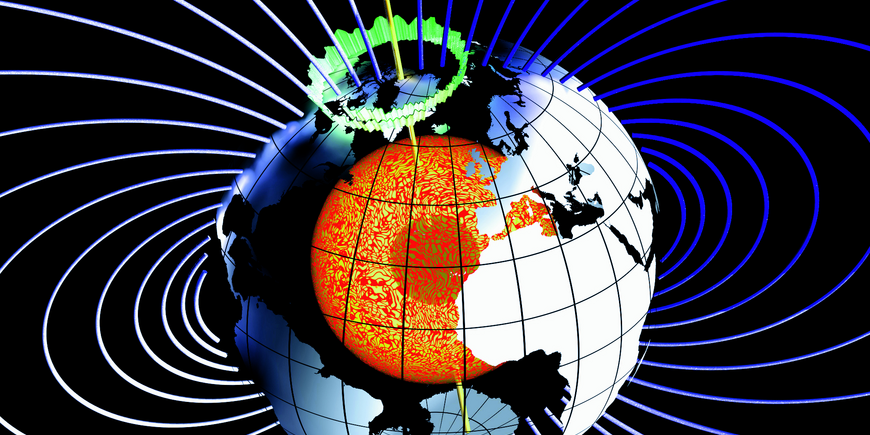20.10.2010 | Potsdam: With three identical satellites, the earth observation mission SWARM will monitor the magnetic field of our planet from June 2012. As part of the "Living Planet" programme of the European Space Agency ESA, the as yet most precise measurement of the geomagnetic field will be used to explore processes within the earth and in near-Earth space. The project is coordinated by the GFZ German Research Centre for Geosciences, a particular focus lies on the scientific and economic use of data products within Germany. The first SWARM satellite has now been completed at Astrium in Friedrichshafen.
"The mission consists of a trio of satellites based on the concept of the geo-research satellite CHAMP," explains Professor Hermann Lühr, project coordinator of SWARM at the GFZ. "At the GFZ we have already gained some surprising insights into the Earth's magnetic field with CHAMP, which also poses new questions. SWARM is to expand our knowledge of the magnetic field. We are hoping for information about electrical current systems in the ionosphere, the magnetic field of the lithosphere, the electron density in the near-Earth space and the magnetic field at the boundary between Earth's core and mantle." Hermann Lühr can build on results present at the GFZ, Potsdam's Helmholtz Centre, which were made available through the evaluation of the CHAMP data.
The magnetic field is weakening
The Earth is exposed to a constant bombardment with energised particles from the sun and from space. Fortunately, the Earth's magnetic field protects us from this dangerous radiation. During the last decades, however, measurements of the magnetic field have shown that the Earth's magnetic field and hence our natural shield are weakening. Precise measurements by the CHAMP satellite revealed that the field strength is decreasing rapidly in certain areas of South America and the South Atlantic. The observed decrease is most pronounced over the South Atlantic with up to 12 percent in 30 years, which happens to coincide with the weak area of the magnetic field. Already now space vehicles suffer most of the experienced interference in this region and International Space Station (ISS) crews receive the highest radiation dose of their voyage here. It is therefore imperative to monitor the unpredictable future development of the Earth's magnetic field accurately. This task can best be addressed by low-orbiting satellites. The European Space Agency’s (ESA) fleet with the three-satellite SWARM is tailored to these challenges.
Magnetized rocks, electrified atmosphere, magnetic ocean currents
High-resolution magnetic field measurements by SWARM will also serve the mapping of magnetized rocks and sediment. The resulting magnetic image of the earth's crust, including the ocean floor, will significantly improve our understanding of geological formations and can be very useful for the detection of minerals and ore deposits.
In addition to the magnetic field, the SWARM satellites will explore the upper, partially ionized and electrically conductive atmosphere. Today, variations in the electron density in this altitude range receive a lot of attention because they scatter radio waves and can disrupt signals from the GPS navigation or even completely interrupt them. The satellite trio is able to detect areas with such scintillations and to transmit this information to GPS users in a short time. This technology can thus make a significant contribution to the security of air traffic.
Another major challenge is the observation of ocean currents. The movement of the electrically conductive salt water produces a weak magnetic field. With CHAMP, the GFZ was the first to succeed in recording magnetic signals of ocean tides and identify them as such. The SWARM mission with its advanced instruments and its specific satellite constellation will enable the monitoring of the large-scale ocean currents in space and time. The dynamics of the oceans play an important role in climate processes. The SWARM mission can make a significant contribution to climate research by helping to uncover the pattern of global ocean circulation.
Professor Reinhard Hüttl, the CEO of the German Research Centre for Geosciences, welcomed the establishment of the SWARM project office at the GFZ: "Satellites are an indispensable instrument of the geosciences. The most successful German space missions were Earth observation missions, and in hardly any other science the path from research to application is as short as the space-based Earth observation."
Pictures in printable resolution








![[Translate to English:] Torsten Sachs in front of a climate station on a field](/fileadmin/_processed_/3/9/csm__TorstenSachs_bearbeitet_GS_4a1365ef84.jpeg)

![[Translate to English:] left image flood at the Ahrtal: image from above, several houses are flooded; left image:: Heidi Kreibich;](/fileadmin/_processed_/4/4/csm_Bild2_9af0130e9f.png)



![[Translate to English:] Start der Vega Rakete](/fileadmin/_processed_/6/4/csm_20231201-kachel_Vega-VV23-launch_ESA-CNES-Arianespace_706716b68c.jpeg)









![[Translate to English:] Poster exhibition at the Brandenburg Hydrogen Day at the GFZ, some participants in the foreground](/fileadmin/_processed_/6/5/csm_Erster_Brandenburgischer_Wasserstofftag_GFZ_402fcec95e.jpeg)
![[Translate to English:] Group picture of the participants](/fileadmin/_processed_/9/4/csm_20231108_CAWa-Workshop-Tashkent_Gruppenbild_99ea779d8a.jpeg)

![[Translate to English:] [Translate to English:] Hörsaal](/fileadmin/_processed_/e/6/csm_H%C3%B6rsal_e21ac645fb.jpeg)


![[Translate to English:] The Delegations in the Historic Library on the Telegrafenberg. In the back there are from left to right, the Dutch Ambassador for Germany, Ronald van Roeden, the Dutch Minister for Education, Culture and Science, Robbert Dijkgraaf and the scientific director of the GFZ, Susanne Buiter.](/fileadmin/_processed_/d/b/csm_Kachel-2_9eba4b4212.jpeg)

